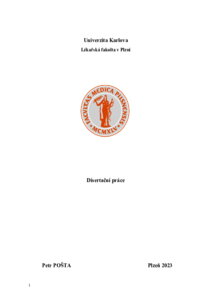Problematika stanovení bezpečných resekčních okrajů u orálních dlaždicobuněčných karcinomů
Controversies in Assessment of Surgical Safety Margins in Oral Squamous Cell Carcinoma
dizertační práce (OBHÁJENO)

Zobrazit/
Trvalý odkaz
http://hdl.handle.net/20.500.11956/189035Identifikátory
SIS: 220814
Kolekce
- Kvalifikační práce [336]
Autor
Vedoucí práce
Oponent práce
Mottl, Radovan
Pink, Richard
Fakulta / součást
Lékařská fakulta v Plzni
Obor
Stomatologie
Katedra / ústav / klinika
Stomatologická klinika
Datum obhajoby
20. 3. 2024
Nakladatel
Univerzita Karlova, Lékařská fakulta v PlzniJazyk
Čeština
Známka
Prospěl/a
Orální dlaždicobuněčný karcinom (oral squamous cell carcinoma - OSCC) je závažné a relativně časté onemocnění dutiny ústní. V současnosti je nadále léčbou volby radikální chirurgické odstranění tumoru. Zanechání reziduálních nádorových buněk v těle pacienta má jednoznačně negativní prognostický efekt. Klíčem k úspěchu této léčebné modality je přesné stanovení rozsahu tumoru a stanovení bezpečné chirurgické hranice resekce tumoru. Za tímto účelem jsou používány, dále zkoumány a nově vyvíjeny doplňující vyšetřující techniky umožňující identifikovat rozsah přítomnosti nádorově změněných buněk. V prezentovaném výzkumu byl zkoumán přínos pre- a peroperačního použití přirozené autofluorescence. Podstatou našeho výzkumu je hypotéza, že použití přirozené autofluorescence, konkrétně systému VELscope (Visually Enhanced Lesion Scope), povede ke zvýšení úspěšnosti chirurgické terapie ve smyslu dosažení nádorových buněk prostého resekčního okraje. Celkový počet 122 pacientů s diagnózou OSCC zařazených do naší studie byl rozdělen po splnění inkluzních kritérií jednoduchou randomizací na studijní a kontrolní skupinu. Před operací každého pacienta ze studijní skupiny bylo provedeno vyšetření přístrojem VELscope společně s vyznačením rozsahu ztráty fluorescence. Pro tento účel jsme vyvinuli unikátní techniku...
Oral squamous cell carcinoma (OSCC) is a serious and relatively common disease of the oral cavity. Radical surgical removal of the tumor currently remains the treatment of choice. Leaving residual tumor cells in the patient's body has a clearly negative prognostic effect. The key to the success of this treatment modality is the accurate determination of the extent of the tumor and the determination of the safe surgical margin of tumor resection. For this purpose, additional investigative techniques are used, further researched and newly developed to identify the extent of the presence of tumor-altered cells. The benefit of pre- and intraoperative use of natural autofluorescence was investigated in the presented research. The essence of our research is the hypothesis that the use of natural autofluorescence, specifically the VELscope (Visually Enhanced Lesion Scope) system, will lead to an increase in the success of surgical therapy in terms of achieving a tumor cell-free resection margin. The total number of 122 patients with a diagnosis of OSCC included in our study were divided after meeting the inclusion criteria by simple randomization into study and control groups. Before surgery, each patient from the study group was examined with a VELscope device together with marking the extent of...
